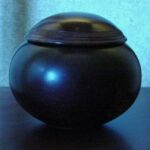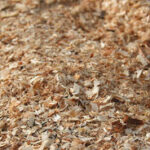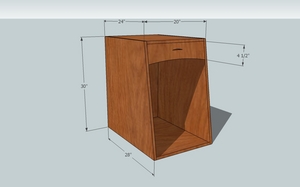Prior to being a woodturner, Super Glue was an obscure tube rarely seen or used, stuck in a kitchen drawer. When I became a woodturner I was surprised to see myself going through bottles of the stuff.
Prior to discussing the wonders of Cyanoacrylate (Super Glue) in woodturning, I’m going to go through a list of dangers. These might seem obvious, but bear with me. The context of this article is the regular use of super glue as a tool, not an obscure tube of adhesive rarely pulled out of a kitchen drawer. Things quick and easy to use that are used regularly are sometimes taken for granted.
Don’t glue yourself to anything, or to yourself. Obvious, but a real concern with cyanoacrylate glues. Consider the use of latex/rubber finishing gloves to protect your fingers and hands from unintended gluing to each other or objects around you.
Have a super glue solvent available. If you do glue yourself to something, being able to work yourself free is a good thing.
Watch out for Fumes! Cyanoacrylate glues can generate nasty fumes, expecially if an exothermic (heat) reaction occurs.
Be aware of materials that can cause an exothermic reaction. I’ve seen small pieces of heavily spalted, airy and dry Maple start to “sizzle”, throw out small plumes of white smoke and fumes, and getting really hot.
Materials I’m aware of that cause an exothermic reaction to super glue:
-Cotton
-Baking Soda
-Perhaps spalted wood if the conditions are right and the spalted wood is dry, light, and airy. I’ve only seen this happen once to the degree it did, I assume because the piece of spalted wood was so dry and airy.
In short, cyanoacrylate super glue is a tool. It is a great tool and works well and quickly, but respect it at all times.
Varieties and uses of Super Glue in Woodturning
Cyanoacrylate super glue is available from any woodturning supplier in several consistencies.
Water Thin Super Glue. Fantastic for hardening or stabilizing soft wood, or for soaking as a finish. Some wood turners will use Super Glue as their Pen finish. When turning wooden pens the amount of wood left around the brass tubes is very thin. Water thin super glue will soak through a great deal of, if not all of that thin layer of wood, depending on the wood species. Once cured you can sand and polish to a pleasing gloss.
Use water thin cyanoacrylate for anything requiring fast wicking, water thin glue.
“Thick” Super Glue. Thick cyanoacrylate is about the consistency of glycerin or honey. It is wonderful for gluing pieces together (e.g. a finial to a lid, or an alternate piece of wood to the neck of a hollow form) because it doesn’t leave a glue-starved joint.
Use thick superglue for anything that requires a glue with some body to it to avoid glue starved joints.
Accelerator. You can buy a small spritz-bottle of cyanoacrylate accelerator which will instantly kick off hardening of super glue. But isn’t cyanoacrylate an “instant” glue? Well, yes and no. Curing might actually take several minutes depending on the type of glue (thick or thin), and will vary based on how it was used. If you have soaked a piece of wood to stabilize it, it’s not a case of a teeny bit of glue between two surfaces anymore.
Super glue is unaffected by water.
Can super glue fail?
This depends on how it was applied and the nature of the joint and application. Cyanoacrylate super glue has low shear strength, meaning the joint can be broken with sideways force to the joint (force parallel to the plane of the joint). Try to pull two pieces of super glued steel apart and you can forget it, it’s not coming apart. However, if you rap one of the pieces of steel on an end you are likely to shear the two pieces apart.
As a practical example in woodturning, consider wooden pen making. The final steps to making the pen are the fitting together of the metal components, which are metal end caps and connectors pressed into brass tubes. In spite of having scored the insides of brass tubes with sandpaper I’ve had numerous parts failures with pens I’ve made over the years if I used super glue for those joints. The push/pull action of parts pressed into the tubes is basically shear force. Consequently I started using two part epoxy on pens.
Low sheer strength can be a good thing, facilitating the use of temporary artifacts like a sacrificial glue block that can be knocked off later (hopefully).
Cyanoacrylate super glue will be a mainstay tool in your woodturning kit. You will appreciate the myriad ways in which it makes woodturning easier, and in some cases possible without having to wait for extended periods of time.
You will be amazed at its ability to harden soft wood, join woodturning components together, enables the rapid construction of glue-blocks and jigs, and even lets you seal up a cut quickly in lieu of band aids.
But don’t take it for granted and pay attention when you are using it. Like anything else, Safety First when in the Shop.
Oh, wait. What was that? Oh, you want to know if I ever Super Glued myself to anything while woodturning?
Umm, well . . . yes.
I had a stellar track record on this score for probably 7 years. I started as a newbie turner, learned of cyanoacrylate, was studious in its use, and managed to avoid the hazing many of the guys liked to give others if they glued themselves to themselves, to tools, or in one case a lathe. That gentleman glued his hand to his 800lb lathe and had no way to reach the solvent/debonder way over yonder in his cabinet. Three hours later his wife came home, responded to his calls for assistance and handed him his solvent.
So, for seven years I was free of hazing. Until the night I was at a woodturning club meeting at the shop of one of our members. I managed to glue my right thumb to a glue bottle in right good fashion, and it wasn’t coming off. With about 20 other wood turners in attendance of course.
It was almost like watching a primitive right of passage as the rest of the “tribe” laughed and patted me on the shoulder, in “innocent” fashion asking where my solvent was. As I sat there tugging futilely at the bottle, the skin of my thumb s t r e t c h i n g in protest, I had to admit I had none with me.
Thankfully one of the “Tribe” handed me a bottle of solvent, and my thumb was free after 10 minutes of solvent laced pulling.
The hazing didn’t stop though.
Sources:Wikipedia.org/wiki/Cyanoacrylate http://en.wikipedia.org/wiki/Cyanoacrylate




